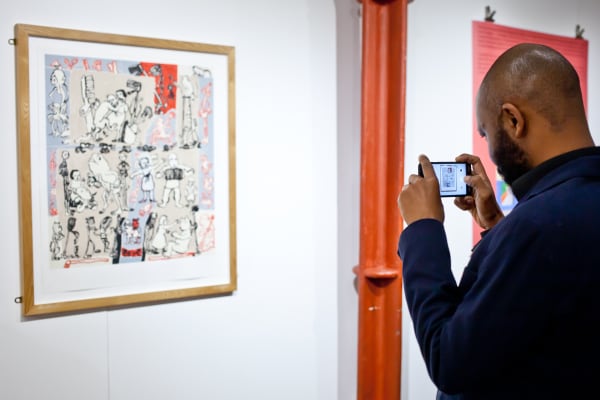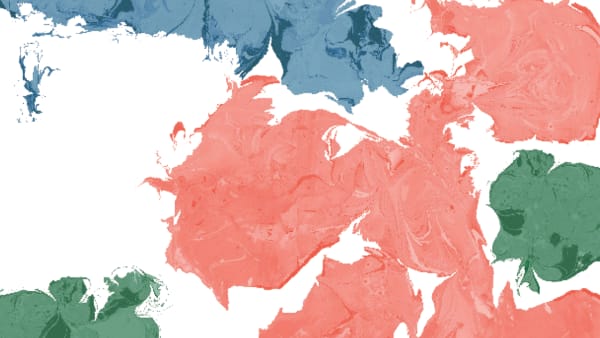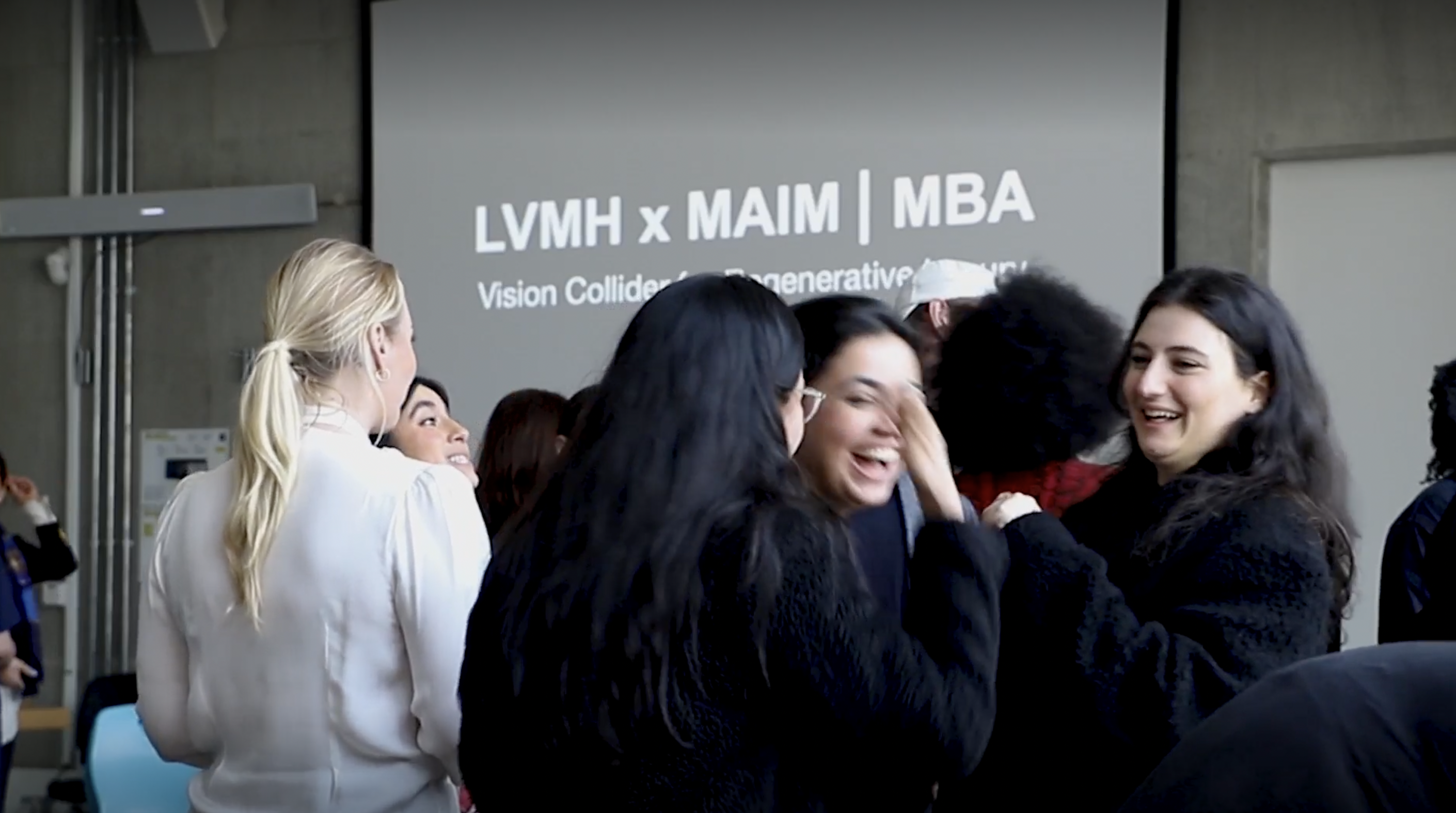Culture and Enterprise students were selected to explore opportunities for regenerative business models for luxury in 2023, after a successful proposal to the Maison/0 Challenge Fund. Working with LVMH and three of its brands - Parfums Christian Dior, Moët Hennessy and Louis Vuitton - 20 MBA and MA Innovation Management students worked in mixed teams to research and develop business proposals in response to briefs from LVMH:
Parfums Christian Dior: ‘How can we create a regenerative value chain? (Team 1)
Moët Hennessy: ‘How can we create a regenerative bar?’ (Team 2)
Louis Vuitton: ‘How can we create regenerative windows?’ (Team 3)
LVMH: ‘How can we creative regenerative global strategies?’ (Team 4)
Maison/0 is the Central Saint Martins – LVMH platform for regenerative luxury. The Maison/0 Challenge Fund grants students and graduates the experience of working on creative collaborations with LVMH. With a 2023 callout on the theme of regenerative luxury, this Culture and Enterprise five day vision collider was one of three successful proposals selected in partnership with LVMH to be taken forward, supported by the Challenge Fund.
Guided by Harah Chon, Course Leader, MBA and Iris Ben-David, Associate Lecturer, MA Innovation Management students came up with ways that the company and its brands could balance exclusivity and profitmaking with benefits to people and place. On the final day they presented their concepts: from bars where customers are sensorially immersed in regenerative experiences, to mimicking processes in nature in window display design and merchandising, to leaders pursuing a culture of collaboration as the basis for generating their global strategies.
Three of the students, Yetunde Abdou (MA Innovation Management), Sasha Alexander (MBA) and Sofia Lee (MBA) reflect on their experiences of working in their teams - and the complexity from the word go of working with regenerative luxury. As Yetunde describes:

Working with LVMH
Groups were briefed by LVMH teams at the start of the week, then researched and prepared presentations for live pitches to LVMH staff and their tutors on day five.
Students are very familiar with group working, but recall how the parameters were different with an external client coming in to them:
“We make so many creative assumptions and have the freedom to set our own project boundaries for course group work, so when you layer in a real client it naturally forces the team to be more realistic and tether the project. The real challenge lay in applying the concept of being regenerative to the luxury industry - which could be argued is a contradictory idea in itself.” - Sasha
To fully engage with the brief and to help hone their pitches, each team worked with mentors from LVMH staff: Kandé Camara (Team 1), Huizi Ouyang & Loïc Zaradzki (Team 2), Sandrine Noël & Nadège Samson (Team 3) and Alexandre Capelli (Team 4).
“The mentors were very supportive in introducing their problem. They were really willing to share their internal materials related to the issue and it was a really good opportunity to understand what they are really struggling with now, what they’re striving for now, and the real voice from inside the brand”. - Sofia
"The tutors were a really great balance of giving us both the room to explore solutions creatively, and then grounding us by asking “okay why and how would we realistically do that?” Their feedback was super direct with real business goals in mind - rather than in a class setting where ideas are more hypothetical or conceptual..” - Sasha
“They were checking in throughout the week, instead of just briefing us on Monday and then seeing what came out on Friday. It was really nice to have a midweek soft presentation to them and have their feedback. Our mentor was very interested in what we had to say and it was all quite transparent, it wasn’t couched in any pretence. – Yetunde.

Real world business context
LVMH has had a sustainable development plan since 1992 and sustainable development is an integral part of the strategic business plans of all LVMH Maisons. The Maison/0 platform in partnership with Central Saint Martins launched in 2021 to leverage creativity and creative education on the road toward regenerative luxury. The LVMH LIFE 360 environment strategy launched in 2020, a 10 year strategy focused on climate, biodiversity, transparency and creative circularity. This includes a target to regenerate 5 million hectares of wildlife habitat by 2030, and a shift into regenerative agriculture.
Taking on the challenges of working towards regenerative practices in a business context, the students experienced some of the dynamics at play:
"Applying regenerative practices to a business setting where success is still defined and motivated by profit is challenging. It’s easy to say “Okay here’s how they can give back to society, its employees, or the earth,” when you’re not also tasked to make money and grow the business at the same time."- Sasha
“In this context, regeneration is a very hard topic and its ultimate goal is not just reducing a negative impact but also creating a very positive impact directly on our ecosystem. That’s really hard because here we’re maintaining this ephemeral lifecycle of the fashion brand’s window. With this challenge we’re talking not only about the environment but about society and the business as well so we broadened our definition to look at positive impact to the social area and rethinking the role of fashion brands’ windows.” - Sofia
“You’re thinking about how this would actually be tenable in a real business context and not just thinking limitlessly. It’s always good to be really creative and radical, but when you’re presenting to people who see something as a real problem in their day to day work, you have to kind of rein it in and say ‘ok, these are the initial steps for me to take and this is how feasible this actually will be.” - Yetunde.
Preparing the pitches
“In terms of our team’s approach, we’re aware that people in Louis Vuitton are all specialists and they wanted help to think outside of the box. In line with the creative ethos in our academic course, we were focused on the research to give them a very coherent and very doable rationale to support our ideas. We’re accustomed to coming up with solutions in a dynamic way so that’s why our team came up with 3 different options - practical, experimental and radical - as a way to respect each team member’s perspective. - Sofia
"We were really able to tap into each other's strengths as a team. My thing is words, and one of my teammates is an amazing Art Director, so it was a great dynamic where she could take what I was saying and communicate that visually perfectly - with the exact look and feel for the deck." - Sasha
"As far as presentation preparation, I think one of the biggest lessons I’ve learned through work is to view who you’re speaking to as a colleague, rather than the brand they work for. Going into a client meeting thinking “I’m speaking to LVMH” is way more daunting than taking a step back and viewing your client as someone who like you, just wants to do their job well.” - Sasha
“When it came to preparing for the pitch, we didn’t use any screens, we ended up writing it out on a Word document and I hadn’t ever done that before. Whenever I work I always work straight in a deck. I put all the ideas in and refine from there. But for this we just had a narrative in our Word document and rehearsed it. That was a really nice way of presenting because you are able not to think of things slide by slide, but the whole story and narrative, and I felt like that really helped us. - Yetunde

Bringing your skills to the team
"Before I came to CSM I worked in advertising, so lots of talking to clients and pitching and being the face of the communication so when it came to starting off the presentation and taking people along through it I was able to do that and take that role. And even though you’re an Account Manager, you’re still researching, you’re still contributing to ideas, so I felt like the week on the LVMH project was kind of the same and maybe it’s that agility that I was able to bring to it.” – Yetunde
“I come from a partnerships and media background, so thinking through how to position an idea, communicate it, or pivot directions on the spot is something I’ve luckily had a ton of experience in. I definitely leaned on those strengths and extended that practice when it came to synthesising the team’s ideas into digestible pieces of information - which is especially important when you only have so much time to present.” Sasha
Regenerative business leadership
One sense Sasha, Sofia and Yetunde have in common is a genuine commitment to a regenerative transformation process on the part of LVMH:
“I was really surprised at how deep they’d already thought about it, all the documents they had. Even though they’re still working in the paradigm of circularity, they’re still thinking ahead and knowing that’s not the dominant way of how they should be thinking about the environment and how they interact with it. So I thought that was really impressive.” - Yetunde.
"Before starting this process I was a little bit sceptical about how seriously big brands are working on this but throughout the process I found that they’re very sincerely striving to solve this problem by each team and each brand. And they were not just focusing on their way, but they are always very open to fresh ideas from students so that was also a very interesting point to learn from them. Businesswise, we saw how the leading company or leading brand have a very authentic attitude towards this problem at a society-level so it was a very good opportunity to learn their mindset, approach and their principles.” – Sofia
“It was really exciting to see how seriously LVMH is taking this - as a consumer, you only see so much, but to actually work with the internal leadership team and hear how they’re tackling the problem was super inspiring.” Sasha

The final pitches
Parfums Christian Dior: ‘How can we create a regenerative value chain?’
Team 1: Corynn Chan, Kate Coffey, Keun Hee Choi, Mira Nagpal and Siluo Duan.
Students focused on redistributing value through the lens of regeneration, defining new metrics for measuring value, and proposing a new value chain framework. They recommended a culture of collaboration throughout the supply chain and all the way to the consumer, expanding the lifespan and functions of products, through repurposing initiatives, upcycling and collectibles and nurturing a regenerative online community with exclusive immersive experiences.
Moët Hennessy: ‘How can we create a regenerative bar?’
Team 2: Agata Kluba, Sasha Alexander, Emma Cordioli, Luqing Cao and Ojasve Nanda
Students reimagined the concept of regenerative viticulture by designing a new customer journey that integrates sustainability throughout the lifecycle of a bar, evoking a sense of belonging and community with a responsible ethos. They thought about how customers can experience regeneration as a concept within a bar setting, through community, shared experiences and settings and our 5 senses. They introduced sound, touch and taste around the biodiversity and plants used to create the beverage, physically touching the earth itself. They considered construction and fit out materials and finishing, zero waste tastings, inclusion of green spaces and biophilic environments, using locally sourced plants, plus connections between cities and countries as a network of local biospheres.
Louis Vuitton: ‘How can we create regenerative windows?’
Team 3: Sofia Lee, Laura Lagleize, Mei Kawabata, Jingyi Feng (Kyra) and Naushin Kaipally.
Students embedded the principles of biomimicry to repurpose, redesign and rethink the future role of regenerative windows. Learning from nature and species, they looked to how hummingbirds make their nests as a parallel to merchandising and window design – they use the resources provided within nature, then weave together and decorate. They then reuse for their next nest. They considered how to capture emotional engagement through windows, creating positive, regenerative impact and generating a high level of fully-fledged empathy – conscious, qualitative awareness. Using windows to inspire the imagination, raise awareness, positive impact socially, high resolution holographic displays, helping people to develop empathy to encourage them to rethink behaviour.
LVMH: ‘How can we creative regenerative global strategies?’
Team 4: Elena Mamchur, Katerina Karnavou, Lena Rissmann, Yetunde Abdou and Oshadhi Deeyagoda Arachchillage.
Students examined LVMH’s present regenerative values and proposed pioneering symbiosis, restoring balance, trusting in localism, designing for interbeing, and partnering with nature. Negotiation and collaboration, more risk-taking, implementing biotechnological initiatives as core practice, bringing new knowledge to practices that are already in action, finding new opportunities. Devotion to heritage and our common culture. Expanding on engaging people beyond purchasing. Inclusion of communities. Specific applications for luxury hospitality, using materials that can return to nature, imagining the future of regenerative hotels, regenerative cuisine. Only using local products, more zero waste. Greater leadership to redefine operations.
Takeaways and thank you’s
“I got to see the differences between how we’re taught and how the MBA students are taught, and what kinds of models and strategies we’re using and they’re using and how we can put them together. So I found that really interesting” – Yetunde.
“For me one of the key takeaways from my entire course is design thinking and I highly appreciate that it’s a very human-centred and customer-centred approach and I was happy that I could apply this approach to this real problem. It was a really good chance for me to see how to apply the academic theory in a real business world problem, so it was most interesting.” - Sofia
“Doing the work on this and how we responded to the brief really hit home for me that one of the most important things brands can do is actually think about how they are communicating with people and the standard they want to set before they go into tactics and stuff like that. That’s my belief, that things start at a brand level, and therefore at a creative level. - Yetunde
“The project honestly felt like a 5-day crash course of the MBA experience - in the best way. It was really affirming for me to put what we’ve learned in the last year to the test - from building, managing, and leading a team, to implementing the frameworks and tools taught in lectures. It was super fulfilling to apply it all to a real challenge in today’s business world, rather than just hypothetically” - Sasha
“We had a really strong sense of criticality, thinking about culture and society as well as business strategy and thinking about how these even small ideas that we’d have, what effect that could create, not just in the room but also to our own belief systems. And that’s something I really appreciated MA Innovation Management growing in us.” - Yetunde
-

Art in Large Doses opening
-

Image by Cara Lloyd
-

Image courtesy of UAL,

